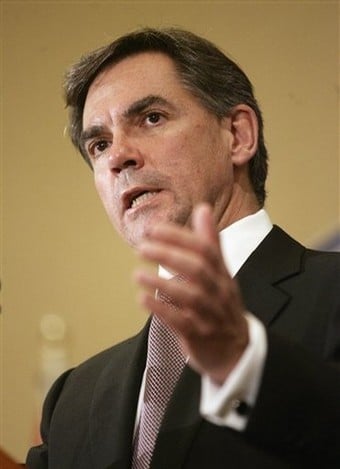it’s official. Canadian Environment Minster Jim Prentice fessed up to what experts have been saying all along: that carbon capture and storage (CSS) is close to useless for mitigating the massive emissions from the Alberta tar sands.
Canadian Prime Minister Harper is no doubt pissed that his potential leadership rival has gone off message on such an important issue of spin.
In an editorial board meeting with Globe and Mail Prentice admitted: “CCS is not the silver bullet in the oil sands.”
Strange. That’s not what his boss said when he committed at least $650 million in taxpayer’s dollars towards this bitumen boondoggle. Harper is a big booster of CSS, stating that:
“This new technology, carbon capture and storage, when fully commercialized … will collect carbon dioxide emissions from oilsands operations and coal-fired electrical plants and seal them deep underground.”
It also obvious that Harper either didn’t read, or care about, the secret memo from his own scientists several months earlier stating exactly the opposite:
“Only a small percentage of emitted CO2 is ‘capturable’ since most emissions aren’t pure enough,” the notes say. “Only limited near-term opportunities exist in the oilsands and they largely relate to upgrader facilities.”
Even using CSS at upgraders is largely a red herring since these facilities are increasingly nowhere near the tar sands. Much of the raw bitumen is now bound for processing south of the border.
So if CSS has almost no utility for reducing tar sands emissions, why does the Prime Minister of Canada keep claiming it does?
The simple reason is that Harper and the Alberta government are terrified that meaningful cap and trade legislation moving through the US Congress will make the already marginal economics of the tar sands even worse.
A recent report showed that oil prices might have to top $110 per barrel to make meaningful emission cuts profitable.
Even with a whopping $2 billion in additional CSS funds from the Alberta government, tar sands operators are giving this supposed panacea a pass.
This year, Shell Oil reneged on a commitment to reduce carbon emissions from a $13.7 billion expansion to conventional levels, even though this exposes them to litigation from environmental groups that threatens their project permitting.
Of course even if CSS worked perfectly at the tar sands without evaporating profitability, it would do nothing about the enormous downstream emissions from burning all that refined oil in cars – four times the production emissions.
None of this has stopped the Harper and Alberta government from shoveling billions in Canadian taxpayers money towards this unproven technology that has yet to be commercialized anywhere in the world.
Yet in the last federal budget, Harper allocated virtually all “green” stimulus money towards CSS – giving virtually nothing, to wind, solar or other green technologies such as modernizing the grid or promoting energy conservation.
Renewable industry representatives were naturally disgusted. Canadian Wind Energy Association president Robert Hornung predicts that existing federal funding may even run out before the end of the coming fiscal year.
“Our ability to compete with the United States for investment in wind energy projects and manufacturing opportunities will decline as a result of this budget. At a time when the United States has made measures to support renewable energy deployment a key component of its plans to stimulate the US economy, Canada is moving in the opposite direction.”
In contrast, President Obama has invested $67 billion towards the renewable energy, stating clearly this is a pillar of the US economy in the coming century. The US is now investing six times as much per capita towards growing their green energy sector.
“We all know that the country that harnesses this new energy source will lead the 21st century,” Obama told the world.
That country will clearly not be Canada.
Subscribe to our newsletter
Stay up to date with DeSmog news and alerts






